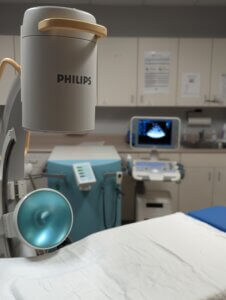 Each year, more than half a million people in the U.S. visit emergency rooms for kidney stone problems. It’s estimated that one in 10 people will have a kidney stone at some time in their lifetime.
Each year, more than half a million people in the U.S. visit emergency rooms for kidney stone problems. It’s estimated that one in 10 people will have a kidney stone at some time in their lifetime.
Kidney stone treatment usually consists of drinking a lot of water to try to let the stone pass without surgery. Certain medications may also help to make urine less acidic. However, if the stone is too large, or if it blocks the flow of urine, or if there is a sign of infection, it is removed with surgery.
ESWL (shockwave treatment lithotripsy for treatment of calculi (stones)), one of the most common treatments for kidney stones in the U.S., is a noninvasive procedure that uses high-energy sound waves from outside the body to target and break up the kidney stone(s) into fragments that are more easily passed out in the urine.
Community Care Urology offers ESWL treatment for kidney stones or other stone disease in Community Care’s accredited Quad A facility, the Interventional and Endoscopy Suite, in Latham, NY. This service is available for patients 18+.
The QUAD A is for office-based outpatient procedures
This space was developed specifically for lithotripsy and other office-based procedures, providing convenient outpatient procedures at lower cost to the patient when compared to expensive hospital settings.
Some important things to know about ESWL:
- ESWL works better with some stones than others. Very large stones may be treated this way with more than one treatment session. The size and shape of stone, where it is lodged in the urinary tract, the patient’s overall health, and the health of the kidney will be part of the decision to use this method of treatment.
- Pregnant women with stones and people with bleeding disorders, infections, severe skeletal abnormalities, or who are morbidly obese are not usually good candidates for ESWL.
ESWL is typically performed as an outpatient non-invasive surgery (no incision). Because there may be pain, light to moderate anesthesia will be used, monitored by a board-certified anesthesiologist. - The recovery time is usually fairly brief. After treatment, the patient can get up to walk almost at once. Many people can fully resume daily activities within one to two days.
- ESWL can be used to treat stones in the ureter as well as in the kidney.
- ESWL is highly focused and therefore, preserves healthy surrounding tissue.
For most patients, imaging is completed to confirm the presence of a kidney stone prior to the patient being referred to a urologist, however, Community Care Urology offers real-time ultrasound imaging when prior imaging has not been done. The urologist will determine if the patient with the stone is a candidate for ESWL, or another form of treatment.
